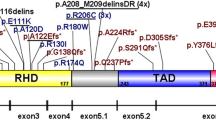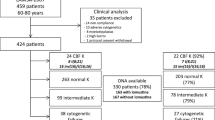Summary
PURPOSE OF REVIEW: In recent years new molecular markers have emerged as significant prognostic parameters and as potential targets for molecularly targeted therapy in acute myeloid leukaemia (AML). Prognostic markers, however, cannot guide the decision for a specific treatment since they are associated with a differential outcome regardless of the given treatment. In contrast, predictive markers indicate a treatment benefit in patients that are characterized through these markers. Thus predictive markers can guide clinical decision-making. RECENT FINDINGS: In young adults mutations of the NPM1 (NPM1 mut) gene in the absence of concurrent FLT3-ITD (FLT3-ITDneg) mutations have impressive prognostic and beyond prognostication also predictive properties. This NPM1 mut/FLT3-ITDneg genotype predicts equivalent favourable outcome after intensive chemotherapy and allogeneic stem cell transplantation, whereas in the absence of this marker clinical outcome was significantly improved after an allogeneic transplantation. In addition, within a retrospective study performed in older adults the same genotype predicted a significantly improved outcome if all-trans retinoic acid was added to intensive chemotherapy. SUMMARY: The discovery of new prognostic and predictive markers has increased our understanding of leukaemogenesis thus leading to an improved prognostication. Furthermore, current clinical research focusing on the assessment of genotype-specific therapy may translate into an increase in the cure rate.
Similar content being viewed by others
References
Gilliland DG, Jordan CT, Felix CA. The molecular basis of leukemia. Hematology Am Soc Hematol Educ Program, 80–97. Review, 2004
Grimwade D, Walker H, Oliver F, et al. The importance of diagnostic cytogenetics on outcome in AML: analysis of 1,612 patients entered into the MRC AML 10 trial. The Medical Research Council Adult and Children's Leukaemia Working Parties. Blood, 92: 2322–2333, 1998
Byrd JC, Mrózek K, Dodge RK, et al. Cancer and Leukemia Group B (CALGB 8461). Pretreatment cytogenetic abnormalities are predictive of induction success, cumulative incidence of relapse, and overall survival in adult patients with de novo acute myeloid leukemia: results from Cancer and Leukemia Group B (CALGB 8461). Blood, 100: 4325–4336, 2002
Fröhling S, Schlenk RF, Kayser S, et al. Cytogenetics and age are major determinants of outcome in intensively treated acute myeloid leukemia patients older than 60 years: results from AMLSG trial AML HD98-B. Blood, 108: 3280–3288, 2006
Kelly LM, Liu Q, Kutok JL, et al. FLT3 internal tandem duplication mutations associated with human acute myeloid leukemias induce myeloproliferative disease in a murine bone marrow transplant model. Blood, 99: 310–318, 2002
Schlenk RF, Döhner K, Krauter J, et al. Mutations and treatment outcome in cytogenetically normal acute myeloid leukemia. N Engl J Med, 358: 1909–1918, 2008
Falini B, Mecucci C, Tiacci E, et al. Gimema Acute Leukemia Working Party. Cytoplasmic nucleophosmin in acute myelogenous leukemia with a normal karyotype. N Engl J Med, 352: 254–266, 2005
Grisendi S, Mecucci C, Falini B, et al. Nucleophosmin and cancer. Nat Rev, 6: 493–505, 2006
Thiede C, Koch S, Creutzig E, et al. Prevalence and prognostic impact of NPM1 mutations in 1485 adult patients with acute myeloid leukemia (AML). Blood, 107: 4011–4020, 2006
Döhner K, Schlenk RF, Habdank M, et al. Mutant nucleophosmin (NPM1) predicts favorable prognosis in younger adults with acute myeloid leukemia and normal cytogenetics: interaction with other gene mutations. Blood, 106: 3740–3746, 2005
Kottaridis PD, Gale RE, Frew ME, et al. The presence of a FLT3 internal tandem duplication in patients with acute myeloid leukemia (AML) adds important prognostic information to cytogenetic risk group and response to the first cycle of chemotherapy: analysis of 854 patients from the United Kingdom Medical Research Council AML 10 and 12 trials. Blood, 98: 1752–1759, 2001
Fröhling S, Schlenk RF, Breitruck J, et al. Prognostic significance of activating FLT3 mutations in younger adults (16 to 60 years) with acute myeloid leukemia and normal cytogenetics: a study of the AML Study Group Ulm. Blood, 100: 4372–4380, 2002
Thiede C, Steudel C, Mohr B, et al. Analysis of FLT3-activating mutations in 979 patients with acute myelogenous leukemia: association with FAB subtypes and identification of subgroups with poor prognosis. Blood, 99: 4326–4335, 2002
Yamamoto Y, Kiyoi H, Nakano Y, et al. Activating mutation of D835 within the activation loop of FLT3 in human hematologic malignancies. Blood, 97: 2434–2439, 2001
Reindl C, Bagrintseva K, Vempati S, et al. Point mutations in the juxtamembrane domain of the FLT3 define a new class of activating mutations in AML. Blood, 107: 3700–3707, 2006
Fröhling S, Scholl C, Levine RL, et al. Identification of driver and passenger mutations of FLT3 by high-throughput DNA sequence analysis and functional assessment of candidate alleles. Cancer Cell, 12: 501–513, 2007
Mead AJ, Linch DC, Hills RK, et al. FLT3 tyrosine kinase domain mutations are biologically distinct from and have a significantly more favorable prognosis than FLT3 internal tandem duplications in patients with acute myeloid leukemia. Blood, 110: 1262–1270, 2007
Whitman SP, Ruppert AS, Radmacher MD, et al. FLT3 D835/I836 mutations are associated with poor disease free survival and a distinct gene-expression signature among younger adults with de novo cytogenetically normal acute myeloid leukemia lacking FLT3 internal tandem duplication. Blood, 111: 1552–1559, 2008
Pabst T, Mueller BU, Zhang P, et al. Dominant-negative mutations of CEBPA, encoding CCAAT/enhancer binding protein-alpha (C/EBPalpha), in acute myeloid leukemia. Nat Genet, 3: 263–270, 2001
Fröhling S, Schlenk RF, Stolze I, et al. CEBPA mutations in younger adults with acute myeloid leukemia and normal cytogenetics: prognostic relevance and analysis of cooperating mutations. J Clin Oncol, 22: 624–633, 2004
Schlenk RF, Döhner K, Kneba M, et al. Gene Mutations and Response to Treatment with All-Trans Retinoic Acid in Elderly Patients with Acute Myeloid Leukemia – Results from AMLSG Trial AML HD98B. Haematologica, 2008 Dec 4. [Epub ahead of print]
Gale RE, Green C, Allen C, et al. The impact of FLT3 internal tandem duplication mutant level, number, size, and interaction with NPM1 mutations in a large cohort of young adult patients with acute myeloid leukemia. Blood, 111: 2776–2784, 2008
Büchner T, Berdel WE, Kienast J, et al. Cytogenetically normal acute myeloid leukemia. N Engl J Med, 359: 651–653, 2008. (Letter to the editor discussing pitfalls of genetic randomization)
Bornhäuser M, Illmer T, Schaich M, et al. Improved outcome after stem-cell transplantation in FLT3/ITD-positive AML. Blood, 109: 2264–2265, 2007. (Letter to the editor showing superior outcome of patients with FLT3-ITDpos AML after allogeneic or autologous SCT compared to chemotherapy, population of the original studies not stated, missing values not addressed, multivariable analysis not included.)
Gale RE, Hills R, Kottaridis PD, et al. No evidence that FLT3 status should be considered as an indicator for transplantation in acute myeloid leukemia (AML): an analysis of 1135 patients, excluding acute promyelocytic leukemia, from the UK MRC AML10 and 12 trials. Blood, 106: 3658–3665, 2005
Arber DA, Vardiman JW, Brunning RD, et al. Acute myeloid leukaemia with recurrent genetic abnormalities. In: Swerdlow SH, Campo E, Harris NL, Jaffe ES, Pileri SA, Stein H, Thiele J, Vardiman JW (eds) WHO classification of tumours of haematopoietic and lymphoid tissues. Fourth edition. WHO Press, Geneva, Switzerland, 2008; pp 120–122
Liu H, Tan BC, Tseng KH, et al. Nucleophosmin acts as a novel AP2alpha-binding transcriptional corepressor during cell differentiation. EMBO Rep 8: 394–400, 2007
Schlenk RF, Fröhling S, Hartmann F, et al. Phase III study of all-trans retinoic acid in previously untreated patients 61 years or older with acute myeloid leukemia. Leukemia, 18: 1798–1803, 2004
Stone R, Fischer T, Paquette R, et al. Phase IB Study of PKC412, an Oral FLT3 Kinase Inhibitor, in sequential and simultaneous combinations with daunorubicin and cytarabine (DA) induction and high-dose cytarabine consolidation in newly diagnosed adult patients (pts) with acute myeloid leukemia (AML) under Age 61. Blood, 108: 157 #abstract, 2006
Preudhomme C, Sagot C, Boissel N, et al. Favorable prognostic significance of CEBPA mutations in patients with de novo acute myeloid leukemia: a study from the Acute Leukemia French Association (ALFA). Blood, 100: 2717–2723, 2002
Author information
Authors and Affiliations
Corresponding author
Rights and permissions
About this article
Cite this article
Kayser, S., Schlenk, R. Tailored therapeutic approaches in acute myeloid leukaemia. memo 2 (Suppl 1), 18–21 (2009). https://doi.org/10.1007/s12254-009-0095-9
Received:
Accepted:
Issue Date:
DOI: https://doi.org/10.1007/s12254-009-0095-9




